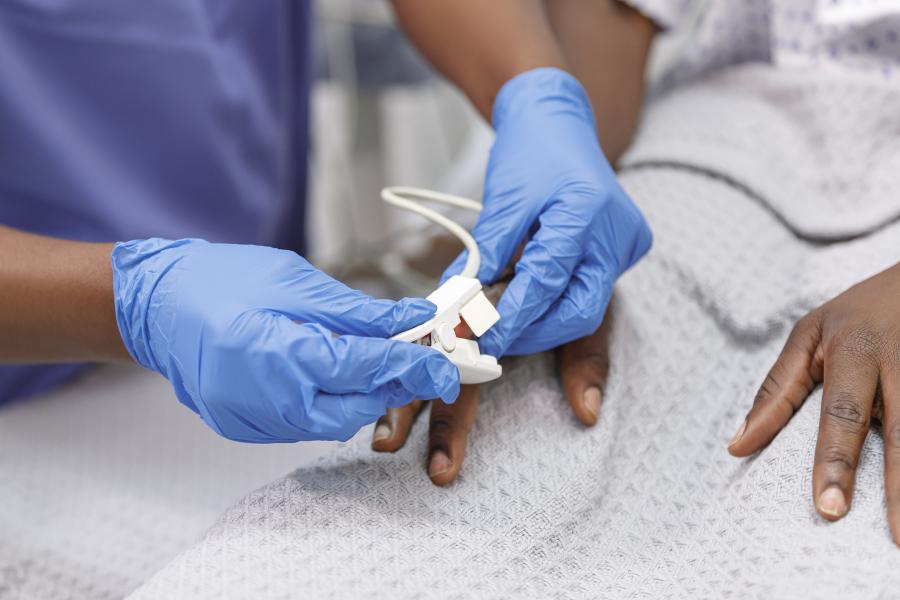- Name
- Maura Kinney
- mkinney4@jhmi.edu
- Office phone
- 443-287-2243
- X
- HopkinsMedNews
A retrospective analysis of more than 7,000 patients with COVID-19 found that pulse oximeter devices—tools that measure oxygen levels in the blood and that are used in virtually every U.S. hospital—overestimated blood oxygen levels in nonwhite patients. The inaccuracy made these patients appear healthier than they were and delayed recognition of their eligibility for specific COVID-19 medications recommended by the Centers for Disease Control and Prevention.
At sea level, most people's blood oxygen level should be from 95% and 100%. Patients with COVID-19, which causes oxygen levels to drop, are at high risk for becoming sicker if their levels go below this range.
"Throughout the pandemic, pulse oximetry has played a prominent role in informing treatment decisions for patients with COVID-19," says Ashraf Fawzy, the study's co-lead author and an assistant professor of medicine at the Johns Hopkins University School of Medicine. "But if pulse oximetry overestimates a patient's blood oxygen levels, that may lead to a delay in treatment or a premature reduction of treatment. Our goal with this analysis was to investigate whether there was a bias in pulse oximeter readings by race and ethnicity among patients with COVID-19 and if that bias potentially led to delays in care."
The analysis was published on May 31 in JAMA Internal Medicine.
The analysis team, co-led by the Johns Hopkins University School of Medicine and Baylor College of Medicine, looked at patient data gathered from the Johns Hopkins Precision Medicine Center of Excellence for COVID-19. Initially, the team focused on more than 1,200 patients with COVID-19 who had concurrently been given two tests that measure blood oxygen levels: pulse oximetry and arterial blood gas, or ABG, tests. By means of a clip-on device, a pulse oximeter device indirectly measures a patient's blood oxygen levels using wavelengths of light. Conversely, ABG tests require a blood sample for a direct measurement. Most patients take only a few, if any, ABG tests during an extended hospital stay. Medical practitioners more frequently use the noninvasive pulse oximetry method.
The team compared the patients' ABG test results to the pulse oximetry results and found that pulse oximetry overestimated blood oxygenation in racial and ethnic minorities. Compared to white patients, pulse oximetry overestimated blood oxygen levels by 1.2% for Black patients, 1.1% among non-Black Hispanic patients, and 1.7% for Asian patients.
To estimate the effect of this bias, the team then looked at more than 6,600 other patients with COVID-19. By applying a statistical prediction model, the researchers found that more than a quarter of these patients—the majority of whom were members of racial or ethnic minority groups—probably qualified for additional COVID-19 therapy before the pulse oximeter identified it. Overall, the researchers found that Black and non-Black Hispanic patients were 29% and 23%, respectively, less likely than white patients to have their treatment eligibility recognized by pulse oximetry.
"Because eligibility for many COVID-19 medications depends on oxygen levels, pulse oximeter tools have become de facto gatekeepers for how we treat patients with this condition," says Tianshi David Wu, the study's co-lead author and an assistant professor of medicine at Baylor College of Medicine. "We've shown that biases in pulse oximeter accuracy can mean the difference between receiving a necessary medication and not—and, critically, we were able to quantify how much this disproportionately affects minority communities."
The team believes the devices' biases could be potential explanations for disparities in COVID-19 outcomes and may have implications for the monitoring and treatment of other respiratory illnesses. More studies to determine the clinical consequences of this bias are ongoing.
Posted in Health








